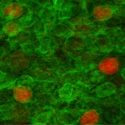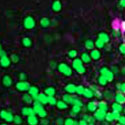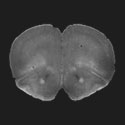Yavin Shaham, Ph.D., Chief of Behavioral Neuroscience Research Branch and Neurobiology of Relapse Section has been awarded the 2022 Ruth L. Kirschstein mentoring award by the National Institutes of Health (NIH) as part of the 2022 NIH Director’s Awards. The NIH Director’s Awards recognizes exceptional performance and special efforts beyond regular job assignments. The Ruth… [Read More]
News Main
Technology Development Initiative – Paper of the Month – November 2022
Transgenic mice for in vivo epigenome editing with CRISPR-based systems. Nature Methods.
Gemberling et al. generated and validated two new Cre-dependent transgenic mouse lines harboring LSL-dCas9-p300 (gene activator/histone acetyltransferase) and LSL-dCas9-KRAB (gene repressor/histone methyltransferase). The authors demonstrated that guide RNAs targeting gene enhancers and the gene promoter are effective at modulating both histone modification state and gene transcription. [Read More]
Misconfigured striatal connectivity profiles in smokers
Featured Paper of the Month – November 2022
Published in Neuropsychopharmacology by Thomas Ross and Elliot Stein of the NIDA IRP Neuroimaging Research Branch.
The striatum, part of the forebrain, is critically involved in reward processes and substance use. Many of the inputs to the striatum come from frontal brain regions. One way to study these connections in living humans is using a technique called functional magnetic resonance imaging (fMRI). A common fMRI approach, resting-state functional connectivity, typically examines the temporal similarity of the signals from two brain areas: essentially looking at the connection between ‘point A’ and ‘point B’…
John Hubbard awarded 2022 Humanitarian & Service PA of the Year Award
John Hubbard, MPAS, PA-C in the NIDA IRP OCD, has been awarded the 2022 Humanitarian & Service PA of the Year Award from the Maryland Academy of Physician Assistants. The MdAPA Humanitarian & Service Award seeks to recognize a PA who has shown incredible service to the community, providing care to the most vulnerable and… [Read More]
Technology Development Initiative – Paper of the Month – October 2022
Dense functional and molecular readout of a circuit hub in sensory cortex. Science.
The Comprehensive readout of activity and cell type markers (CRACK) platform combines multi-area two photon calcium imaging microscopy with hybridization chain reaction–fluorescence in situ hybridization (HCR-FISH) to label and track mRNA. CRACK allows researchers to first observe the electrical firing of neurons in the brain of a live mouse during a behavioral task, and then track the expression of specific genes in slices of the animal’s brain, ultimately linking specific cells and their molecular signatures to behaviors. [Read More]
Nonsuicidal Self-Injury and Substance Use Disorders: A Shared Language of Addiction
Featured Paper of the Month – October 2022
Published in Proceedings of the Eighth Workshop on Computational Linguistics and Clinical Psychology by Salvatore Giorgi and Brenda Curtis, et al. of the NIDA IRP Technology and Translational Research Unit.
Nonsuicidal self-injury (NSSI), or the deliberate injuring of one’s body without intending to die, has been shown to exhibit many similarities to substance use disorders (SUDs), for example comorbidity with anxiety and depression. Research has further shown that people who self-injure adopt language common in SUD recovery or 12-step communities. Using over 150,000 comments from approximately 5,000 people posting on the social media website Reddit, we investigate the shared language of NSSI and SUD by comparing discussions on public forums related to self-injury and drug addiction…
Acts of appetite: neural circuits governing the appetitive, consummatory, and terminating phases of feeding
Reviews To Read – September 2022. Published in Nature Metabolism and coauthored by Ana Pamela Miranda Tapia and Yeka Aponte of the Neuronal Circuits and Behavior Section (NIDA IRP) and Ivan C. Alcantara and Michael J. Krashes of the Section on Motivational Processes Underlying Appetite (NIDDK IRP). For decades, the prevalence of obesity has surged due… [Read More]
Technology Development Initiative – Paper of the Month – September 2022
SMART: An Open-Source Extension of WholeBrain for Intact Mouse Brain Registration and Segmentation. eNeuro.
Jin et al. presents an optimized protocol for Fos staining, a marker of neuronal activation, in a cleared mouse brain and provide an open-source R package called SMART (Semi-Manual Alignment to Reference Templates) as an extension to the Wholebrain pipeline (PMID: 29203898). SMART is designed to make whole-brain activity mapping more accessible to researchers looking to implement the technique and analysis into their research program. [Read More]
Target deconvolution studies of (2R,6R)-hydroxynorketamine: an elusive search
Featured Paper of the Month – September 2022
Published in Molecular Psychiatry by Jordi Bonaventura and Michael Michaelides, et al. of the NIDA IRP Biobehavioral Imaging and Molecular Neuropsychopharmacology Unit.
The use of racemic ketamine and the FDA approval of (S)-ketamine are promising developments for the treatment of depression. Nevertheless, racemic ketamine and (S)-ketamine are controlled substances with known abuse potential and their use is associated with undesirable side effects. For these reasons, research efforts have focused on identifying alternatives. One candidate is (2R,6R)-hydroxynorketamine ((2R,6R)-HNK), a ketamine metabolite that in animal studies lacks the dissociative and abuse properties of ketamine while retaining its antidepressant-like behavioral efficacy…
Synaptic-like axo-axonal transmission from striatal cholinergic interneurons onto dopaminergic fibers
Hot Off the Press – August 15, 2022 Summary Communication between brain cells (neurons) generally involves the unidirectional flow of information. Input from upstream cells arrives onto the dendrites, gets processed in the cell body where it is converted into a rapid electrical wave (action potential) that travels down the axon to trigger the release… [Read More]










